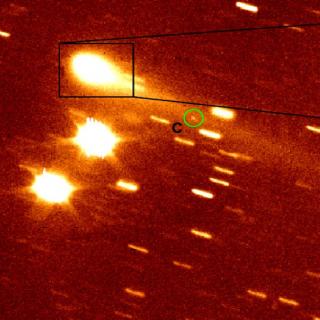Bibcode
Brozović, Marina; Jacobson, Robert A.; Park, Ryan S.; Descamps, Pascal; Berthier, Jérôme; Pinilla-Alonso, Noemí; Popescu, Marcel; Licandro, Javier
Referencia bibliográfica
The Astronomical Journal
Fecha de publicación:
3
2024
Número de citas
1
Número de citas referidas
1
Descripción
We report on the ephemeris development for Menoetius, the satellite of Patroclus. Our data set consisted of ground–based and Hubble Space Telescope relative astrometry, as well as 42 lightcurves from the mutual events seasons in 2007, 2012, and 2017/2018. Our dynamical model included the effects of oblate, nonspherical shapes of the components, and we assumed that Menoetius contained ∼22% of the system's mass. We numerically integrated the equations of motion and obtained a set of dynamical parameters that fit the data. We report the fit results in terms of residuals, state vectors, orbital elements and their 1σ uncertainties. The mean osculating semimajor axis is a = 692.5 ± 4.0 km, the mean eccentricity is e = 0.004 ± 0.004, and the International Celestial Reference Frame pole direction in R.A. and decl. is R. A. = 178.0 ± 0.5 deg, δ = ‑74.1 ± 0.2 deg. We determined the siderial orbital period of P = 4.282753 ± 0.000023 days. The fit yielded the system GM = 0.0950 ± 0.0012 km3 s‑2, which, in combination with the system volume determined from the stellar occultation and the assumed volume uncertainty of 20%, suggests a system bulk density of 1.05 ± 0.21 g cm‑3(1σ). The next season of mutual events starts in February of 2024 and lasts until January of 2025. The Patroclus system is in opposition for the observers on Earth in late September and is suitable for observations of the mutual events with an edge-on geometry in October.
Proyectos relacionados

Pequeños Cuerpos del Sistema Solar
Este Proyecto estudia las propiedades físicas y composicionales de los llamados pequeños cuerpos del Sistema Solar, que incluyen asteroides, objetos helados y cometas. Entre los grupos de mayor interés destacan los objetos trans-neptunianos (TNOs), incluyendo los objetos más lejanos detectados hasta la fecha (Extreme-TNOs o ETNOs); los cometas, y
Julia de
León Cruz